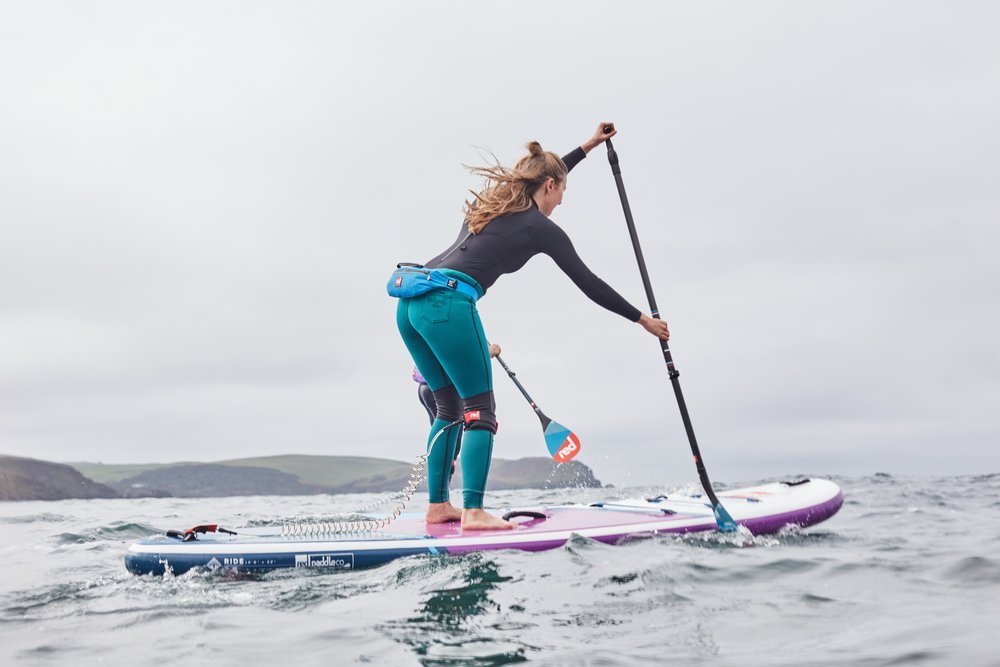The paddleboarding experience is different depending on the type of water you choose. Endeavouring to set out on the ocean with the same mindset and equipment that is used when paddling on lakes will only lead to under-preparedness and a more strenuous experience. The reverse also being true.
Many will choose to start paddleboarding for the first time, set out on their local lake or along their shore, only to find that the experience wasn’t what they expected. This is often because they have been told information specific to one environment, not being prepared for the other. However, once the key differences between both bodies of water are understood, paddleboarders can easily enjoy them both.
Mounting The Board
The first thing you will notice when mounting your board at sea is that it can be quite difficult. The waves and current tend to affect a board’s stability more readily, making it trickier to get comfortable. As such, and unlike lakers, paddleboarders should work to find a suitable spot to mount their board instead of attempting to do so in open water.
Reading The Water
The tides and waves make reading the ocean key. At any moment, waves can throw a paddleboarder off balance while, gradually over a session, the tide can pull individuals further out than they feel comfortable. As such, it’s not only important to understand the tide’s activity before you head out onto the water but it’s also important to maintain concentration on the water to ensure you remain comfortable.
Lakes, however, are generally much more placid and seldom tidal, making them more appropriate for beginners. Occasionally paddleboarders might want to explore further, which means staying safe on rivers and other bodies of water that might be more temperamental.
Reading Others
Lakes might host other paddleboarders, as well as swimmers, and it remains important to be aware of your surroundings. In addition to the risk of being knocked off of your board, there is also the chance that your paddle may strike someone else enjoying the water.
The same risks occur at sea but there are also boats to consider. In addition to being aware of boating movements, paddleboarders should also be aware of the effect they have on the water. Fast-moving boats especially can have a significant effect on the surface of the water, creating waves that easily tip paddleboarders from their boards. Be sure to have your paddleboard strap connected at all times!
Weather Forecasting
The changes in weather can affect both sea and lake environments equally. However, depending on your specific and local landscape, they may have different impacts. Launching from the shore will have you more likely exposed to coastal winds and full sun, meaning that you should be more aware of both air currents and sun exposure.
Lakes tend to offer more shelter from adverse conditions, which is why they are often referred to as flat water and host those wanting to practice stand-up paddleboarding yoga. However, they can just as easily be affected by heavy rains, so don’t get too comfortable!
Related posts
Recent Posts
- The Cincinnati to Miami Private Jet Experience October 23, 2023
- Canada Immigration Agencies in India: Navigating the Path to Canadian Residency October 3, 2023
- Professional Services offered by Best Visa Consultants in Qatar for Canadian Immigration October 3, 2023
- The Bahamas’ Most Luxurious Private Island Rentals: A Closer Look August 2, 2023
- What Makes Travel Insurance A Financially Sensible Option? July 4, 2023
Archives
- October 2023
- August 2023
- July 2023
- March 2023
- January 2023
- December 2022
- November 2022
- October 2022
- September 2022
- August 2022
- July 2022
- June 2022
- May 2022
- April 2022
- March 2022
- February 2022
- January 2022
- December 2021
- November 2021
- October 2021
- September 2021
- July 2021
- June 2021
- May 2021
- April 2021
- March 2021
- February 2021
- January 2021
- December 2020
- November 2020
- October 2020

